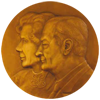
Helena Brisby, professor at the Department of Orthopaedics, University of Gothenburg, and chief physician at Sahlgrenska University Hospital. She is researching what causes pain in the lower back. NOTE – This article is machine translated from Swedish.
Chronic back pain is not only a concern for the victims. Including socio-economic, it is a big problem. Over 30 billion a year is Bill for back treatments in Sweden.
It is almost twenty years ago Helena Brisby stepped in as a PhD student at the Department of Orthopedics in Gothenburg. Then she were spurred by the challenge of understanding what it is that is causing the pain in the low back. The interest has been keeping itself and the back turned out to be a true research challenge. Still looking for she and her colleagues after the key to what is causing the pain. Various factors can cause pain in the lower back and legs but in many patients it is hard to find an exact cause.
— It limits our ability to help patients with pain in the back. We want to develop the current diagnostic methods to be able to give everyone a better treatment, says Helena Brisby.
One of the projects is to affect the back disks with stem cells to combat degradation and help them stay elastic. In the experiments used both human bone marrow and animal models and research team is ready to provide patients with disk degeneration transplant of their own stem cells. Perhaps it will lead to a new and effective method of treatment.
— If we with a less invasive procedures can use fit, healthy cells that we insert in the drive, it would be very worthwhile, and maybe be able to replace some of the major operations.
Today’s options for those with severe chronic back pain, where physical therapy and pain-relieving medicine does not work, is Arthrodesis or operation with the disk replacement. But it does not cure the underlying problems. For some it relieves not even pain.
The research team are also studying how underlying cell mechanisms affecting the development of disc degeneration, disc herniation and sciatica. A third project is to see what are the effects of physical activity have on the injured back disks. This is done by letting the rats run on treadmills.
— We want to know if training has positive effects on the disks. It would have been great to be able to motivate people with such results.
Helena Brisbys networks is a motley crew of scientists with different specializations, such as neurophysiology, cell-based therapy, biomaterial and spinal surgery. Their place of work in an older building at Sahlgrenska hospital has airy rooms with high ceilings, and in all equipment purchased due to numerous grants from No Britt and Arne Lundberg’s Research Foundation.
It is time to replace a lot of the equipment is worn out and obsolete. Therefore, the new funding from the Foundation in good stead.
Helena shows some advanced models in the cellodlings room. In a Hall next to the ongoing teaching and further away in the Corridor passes two visitors to the movement-the lab.
— There are many researchers who work with very different projects here on the premises.
Laing laboratory, as it is called, has grown gradually since 1995 when it received the first donation. Now they have two more lab at mölndal hospital area. Helena Brisby has been through the entire journey and today she is, apart from his research position, head of the Department of Orthopedics with 58 students.
In addition, she appreciates his job with patients at the orthopaedic clinic and takes on the operationskläderna one to three days a week.
— It is sometimes pure strength training session to operate a lumbar spine. I am often quite sweaty afterwards. Going to the gym is not for me, the training I get at work.
Text and photo: Monica Havström
